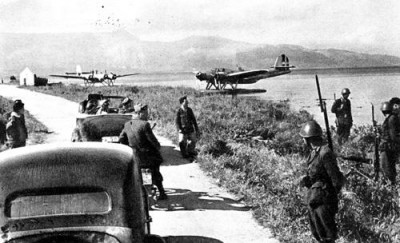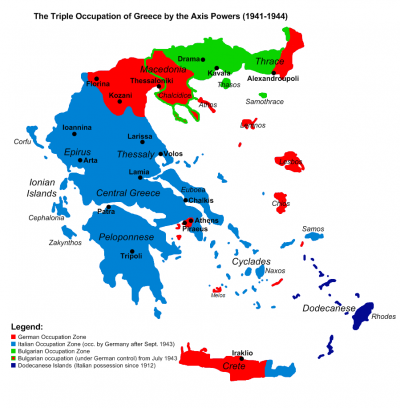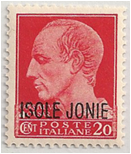ALBUM – view my Italian Occupation of the Ionian Islands album
TRANSITION CHART for the Ionian Islands
Fast Facts
Region: Aegean / Ionian Sea
Group: World War 2 Occupations
Classification: Military Occupation
Prior Regime: Italian Occupation of individual islands, Kindom of Greece.
Key Dates:
1940, Oct – Italy first attemped to invade Greece from Albania, but were driven back by the Greek Army
1941, Apr – Germany and Italy invade Greece including Crete, the Ionian and Aegean Islands.
1943, Sep 14 – Facist Italy fell and Nazi Germans invaded and took control of the Ionian Islands
1944, Oct 14 – The British Marines liberated Corfu and the Ionian Islands from the Germans
Following Regime: German Occupation of the Ionian Islands in WW2Scott Catalogue: (Ionian Islands) #N18-N25, NC12, NJ1-NJ4
Pick Catalogue: (Greece, Italian Occupation of the Ionian Islands) #M11-M18
Currency: 100 centimes = 1 Italian Lira
History

In the 1800s, the islands were a British Protectorate, and were transferred to Greek rule in 1862. As World War 2 began, Italy initially invaded Greece in October 1940, but the invasion was halted after the Greek army was able to push the Italian army back into Albania. This forced the Germans, allies of Fascist Italy, to shift military plans in the north and come to the aid of Italy. The combined forces were able to engage the Greek forces in April 1941, and by the middle of May, Greece was occupied by the Nazis. While Germany occupied and administered the important cities, such as Athens and Thessaloniki, the Bulgarians controlled the eastern portion of the country, while Italy controlled the majority of the Peloponnesian peninsula, including the Ionian Islands.
 The invasion and control of Corfu and the Ionian Islands, was part of Mussolini’s strategy to resurrect the Roman Empire, as Corfu has been an important outpost in the Adriatic. It was less than 20 years prior, in 1923, the Italians invaded Corfu in a feeble attempt to annex the island, but the occupation only lasted for a short period. The Italians ruled Corfu and the Ionian Islands as a separate entity from the rest of Greece, and several proposals for annexation had been put forward in Rome, none was actually carried out during the war due to pressure from the King of Italy, Victor Emmanuel III, and from the Germans, who were concerned of further alienating the Greek population, which was already strongly opposing the Bulgarian annexations.
The invasion and control of Corfu and the Ionian Islands, was part of Mussolini’s strategy to resurrect the Roman Empire, as Corfu has been an important outpost in the Adriatic. It was less than 20 years prior, in 1923, the Italians invaded Corfu in a feeble attempt to annex the island, but the occupation only lasted for a short period. The Italians ruled Corfu and the Ionian Islands as a separate entity from the rest of Greece, and several proposals for annexation had been put forward in Rome, none was actually carried out during the war due to pressure from the King of Italy, Victor Emmanuel III, and from the Germans, who were concerned of further alienating the Greek population, which was already strongly opposing the Bulgarian annexations.
On the 14th September 1943, after fascism fell in Italy, the Nazis attacked Corfu, bombarding island. The Italians surrendered and the Germans occupied Corfu and the rest of the islands. On the island of Cephalonia, General Antonio Gandin, commander of the 12,000-strong Italian Division decided to resist the German attempt to forcibly disarm his force. The battle raged from 13–22 September, but the Italians were defeated. After the Italians surrendered, the German army massacred several thousand Italian prisoners of war, which stands as one of the worst single war crimes committed by the Nazi’s.
In early June 1944, while the Allies bombed Corfu as a diversion from the Normandy landings, the Gestapo rounded up the Jews of the city and temporarily incarcerated them in the old fortress. On the 10th of June they sent them to Auschwitz where very few survived. Ultimately the Ionian Islands were liberated on 14 October 1944 by the British Royal Marines.
Stamps
 ALBUM
ALBUM
At beginning of the occupation, the Italians had the existing stocks of Greek stamps on the islands overprinted with Corfu or Cefalonia & Itaca. (issued June 1941). In August 1941, Italian stamps (postage, air and postage due) with the overprint of “Isole Jonie”, Italian for Ionian Islands replaced the overprinted Greek stamps. These stamps were used across the islands for postage. There is also a postcard with an imprinted Italian stamp which received a similar overprint.
These stamps were replaced with German overprinted stamps in 1943 when the Germans assumped control from the Italians.
Banknotes
During the occupation, a series of 7 Isole Jonie banknotes featuring various Roman scenes and images were issued. The denominations were: 1, 5, 10, 50, 100, 500, 1.000, and 5.000 drachmai. The banknotes were replaced with German Occupation notes in 1943.
Links
Ionian Islands from Wikipedia
Axis Occupation of Greece in WW2 from Wikipedia
Postage Stamps and Postal History of Greece




